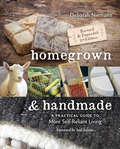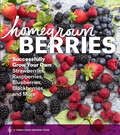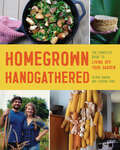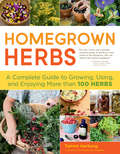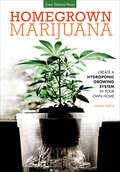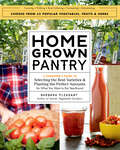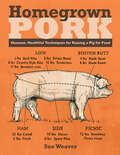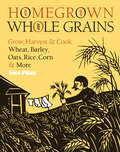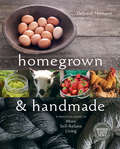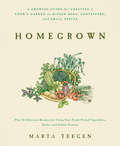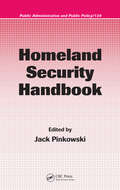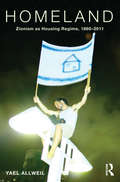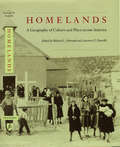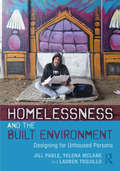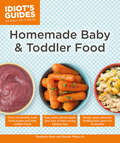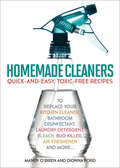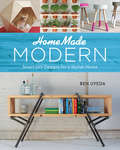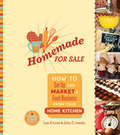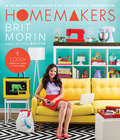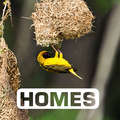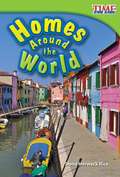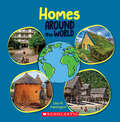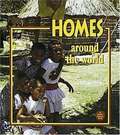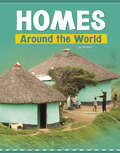- Table View
- List View
Homegrown & Handmade: A Practical Guide to More Self-Reliant Living
by Deborah NiemannThe author of Ecothrifty shows you how to life more self-sufficiently with her guide to modern homesteading―no farm required.Food recalls, dubious health claims, scary and shocking ingredients in health and beauty products. Our increasingly industrialized supply system is becoming more difficult to navigate, more frightening, and more frustrating, leaving us feeling stuck choosing in many cases between the lesser of several evils. That&’s why author Deborah Niemann is here to offer healthier, more empowering choices, by showing us how to reclaim links in our food and purchasing chains, to make choices that are healthier for our families, ourselves, and our planet.In this fully updated and revised edition of Homegrown and Handmade, Deborah shows how making things from scratch and growing some of your own food can help you eliminate artificial ingredients from your diet, reduce your carbon footprint, and create a more authentic life.Whether your goal is increasing your self-reliance or becoming a full-fledged homesteader, this book is packed with answers and solutions to help you rediscover traditional skills, take control of your food from seed to plate, and much more. This comprehensive guide to food and fiber from scratch proves that attitude and knowledge is more important than acreage. Written from the perspective of a successful, self-taught modern homesteader, this well-illustrated, practical, and accessible manual will appeal to anyone who dreams of a more empowered life.&“Dreaming of a mindful life? Niemann&’s advice on gardening, cooking, orcharding, raising livestock, and much more demonstrates that it&’s possible to begin the journey in your own backyard.&” —Rebecca Martin, Managing Editor, Mother Earth News
Homegrown Berries: Successfully Grow Your Own Strawberries, Raspberries, Blueberries, Blackberries, and More
by Timber PressEnjoy delicious, nutritious berries from your own backyard! What says summer more than a bowl full of fresh berries? How about a yard full of them? Homegrown Berries covers the information you need to know about the process from planting to picking. You’ll learn the best varieties of strawberries, raspberries, blackberries, blueberries, gooseberries, currants, and elderberries for you, how to fit them into your landscape (including in borders and containers), and how to maintain them for peak harvest. Summer just got sweeter!
Homegrown Handgathered: The Complete Guide to Living Off Your Garden
by Silvan Goddin Jordan TonyUse your garden to grow a balanced diet that fulfills your nutritional needs and your cravings for a more sustainable life. Growing your own food is good for you and the planet. Backed by scientific research, Indigenous knowledge, and the authors’ years of firsthand experience, Homegrown Handgathered offers field-tested techniques for beginners and experts alike to thrive off the bounty of the land with confidence. This complete manual for organic food production will show you how to select a site, plan your garden, source and start seeds, manage pests and weeds, compost, preserve your harvests, and more. Comprehensive growing guides for more than 15 essential crops—from beans, carrots, and corn to squashes, sweet potatoes, and tomatoes—detail favored growing conditions, processing tips, key nutrients, and more. Each crop chapter also features easy-to-follow recipes from a range of cultures that will transform your harvest into delicious, nourishing meals. From Jalapeño Cornbread and Oyster Mushroom Grits to Venison Borscht and Walnut-Shiitake Burgers, gardening never tasted so good!
Homegrown Herbs: A Complete Guide to Growing, Using, and Enjoying More than 100 Herbs
by Tammi HartungEnjoy a thriving, fragrant herb garden and use your harvest to bring beauty, flavor, and health to your everyday life. Tammi Hartung provides in-depth profiles of 101 popular herbs, including information on seed selection, planting, maintenance, harvesting, and drying. Hartung also shows you how to use your herbs in a variety of foods, home remedies, body care products, and crafts. Whether you&’re a seasoned herbalist or planting your first garden, Homegrown Herbs will inspire you to get the most out of your herbs.
Homegrown Marijuana: Create a Hydroponic Growing System in Your Own Home
by Joshua SheetsA gardener’s guide to growing marijuana plants. If growing Cannabis is permitted where you live, a hydroponic system is your homegrown solution.With marijuana laws changing rapidly, millions of gardeners with an interest in growing Cannabis can finally step out of their curtained basements and raise this unique and ancient plant without worry and in plain view.As with any other plant we grow, you’ll find a wide range of strategies for growing marijuana. The variables between approaches are many, including success rates, security, and cost. Indoor, water-based hydroponic systems are the best option for just about any homeowner: they are clean, reliable, highly productive, and can be built for minimal cost. In Homegrown Marijuana, you’ll find all the information you need to create and operate a hydroponic growing system in your own home.This book is intended for people who live in areas that have legalized growing marijuana, for medical use or otherwise, and who wish to produce it for their own consumption. Using step-by-step instructions and photos, hydroponics and marijuana-growing expert Joshua Sheets explains how to create, build, maintain, and harvest a marijuana garden. He also includes plenty of background information you’ll want to know on subjects such as nutrient solutions, propagating plants, selecting varieties, troubleshooting problems, and much more. You’ll see that a hydroponic marijuana garden is not so different from other gardens you’ve grown—except, of course, that in this garden, the weed is encouraged.
Homegrown Pantry: A Gardener's Guide to Selecting the Best Varieties & Planting the Perfect Amounts for What You Want to Eat Year-Round
by Barbara PleasantNow that you&’ve mastered gardening basics, you want to enjoy your bounty year-round, right? Homegrown Pantry picks up where beginning gardening books leave off, with in-depth profiles of the 55 most popular crops — including beans, beets, squash, tomatoes, and much more — to keep your pantry stocked throughout the year. Each vegetable profile highlights how many plants to grow for a year&’s worth of eating, and which storage methods work best for specific varieties. Author Barbara Pleasant culls tips from decades of her own gardening experience and from growers across North America to offer planting, care, and harvesting refreshers for every region and each vegetable. Foreword INDIES Silver Award Winner GWA Media Awards Silver Award Winner
Homegrown Pork: Humane, Healthful Techniques for Raising a Pig for Food
by Sue WeaverRaising a pig for meat is easy to do, even in a small space like a suburban backyard. In just five months, a 30-pound shoat will become a 250-pound hog and provide you with more than 100 pounds of pork, including tenderloin, ham, ribs, bacon, sausage, and more. Homegrown Pork covers everything you need to know to raise your own pig, from selecting a breed to feeding, housing, fencing, health care, and humane processing. Invite all your friends over for a healthy and succulent pork dinner!
Homegrown Whole Grains: Grow, Harvest, and Cook Wheat, Barley, Oats, Rice, Corn and More
by Sara PitzerLearn to grow, harvest, store, grind, and cook nine popular whole grains. Sara Pitzer provides complete instructions for growing your own wheat, corn, barley, millet, oats, rice, rye, spelt, and quinoa, as well as recipes for using these grains in tasty dishes. Cultivating these crops is surprisingly easy, and it takes less space than you might imagine — with just 1,000 square feet of growing space in your backyard, you can grow enough wheat to supply ingredients for 50 loaves of delicious fresh bread.
Homegrown and Handmade
by Deborah NiemannOur food system is dominated by industrial agriculture and has become economically and environmentally unsustainable. The incidence of diet-related diseases, including obesity, diabetes, hypertension, cancer, and heart disease, has skyrocketed to unprecedented levels. Whether you have forty acres and a mule or a condo with a balcony, you can do more than you think to safeguard your health, your money, and the planet.Homegrown and Handmade shows how making things from scratch and growing at least some of your own food can help you eliminate artificial ingredients from your diet, reduce your carbon footprint, and create a more authentic life. Whether your goal is increasing your self-reliance or becoming a full-fledged homesteader, it's packed with answers and solutions to help you:*Take control of your food supply from seed to plate*Raise small and medium livestock for fun, food, and fiber*Rediscover traditional skills to meet more of your family's needs than you ever thought possibleThis comprehensive guide to food and fiber from scratch proves that attitude and knowledge is more important than acreage. Written from the perspective of a successful self-taught modern homesteader, this well illustrated, practical, and accessible manual will appeal to anyone who dreams of a simpler life.Deborah Niemann is a homesteader, writer, and self-sufficiency expert who presents extensively on topics including soapmaking, bread baking, cheesemaking, composting, and homeschooling. She and her family raise sheep, pigs, cattle, goats, chickens, and turkeys for meat, eggs, and dairy products, while an organic garden and orchard provides fruit and vegetables.
Homegrown: A Growing Guide for Creating a Cook's Garden
by Marta TeegenSwap the annuals for edibles, creating attractive beds and containers that both beautify the yard and provide a bounty of fresh produceAs a trained chef-turned-professional kitchen garden designer, Marta Teegen knows what a difference freshly harvested vegetables can make to a meal—and how easy it is to ensure seasonal vegetables are always available when you need them. She touts the joys creating front yard–friendly raised beds and container gardens that take up only a small amount of space and look beautiful to boot, and shares ideas for tucking productive gardens in other small nooks and corners.Teegen's unique cuisine-based planting methods mean herbs, vegetables, and edible flowers grow next to each other in comingled plots—quickly, reliably, and efficiently. You'll find more than 40 top picks for small-space vegetables that yield big and are trouble-free, plus a variety of menus and 50 recipes for fresh and delicious summer dishes.With food prices on the rise and concern over pesticide residues on produce ever present, the number of home owners growing vegetables nearly doubled in the last year. Homegrown shows that even urban and suburban dwellers can grow their own vegetables in easy-to-tend plots and spaces.
Homeland Security Handbook (Public Administration and Public Policy)
by Jack PinkowskiBlinded by emotional rhetoric, political posturing, and genuine fear, previous efforts to defend our way of life against aggressors intent on inflicting personal and economic destruction have proven, in hindsight, to be misguided, panicked, and reactionary. Evaluation and assessment to date is largely focused on reviewing government documents, doin
Homeland: Zionism as Housing Regime, 1860–2011 (Planning, History and Environment Series)
by Yael AllweilOn 29 March 2016 the New York based online journal, Realty Today reported ‘Israel is facing a housing crisis with …[the] home inventory lacking 100,000 apartments… House prices, which have more than doubled in less than a decade, resulted in a mass protest back in 2011’. As Yael Allweil reveals in her fascinating book, housing has played a pivotal role in the history of nationalism and nation building in Israel-Palestine. She adopts the concept of ‘homeland’ to highlight how land and housing are central to both Zionism and Palestinian nationalism, and how the history of Zionist and Palestinian national housing have been inseparably intertwined from the introduction of the Ottoman Land Code in 1858 to the present day. Following the Introduction, Part I, ‘Historiographies of Land Reform and Nationalism’, discusses the formation of nationalism as the direct result of the Ottoman land code of 1858. Part II, ‘Housing as Proto-Nationalism’ focuses on housing as the means to claim rights over the homeland. Part III, ‘Housing and Nation-Building in the Age of State Sovereignty’, explores the effects of statehood on national housing across several strata of Israeli society. The Afterword discusses housing as the quintessential object of agonistic conflict in Israel-Palestine, around which the Israeli polity is formed and reformed.
Homelands: A Geography of Culture and Place across America (Creating the North American Landscape)
by Richard L. Nostrand Lawrence E. EstavilleWhat does it mean to be from somewhere? If most people in the United States are "from some place else" what is an American homeland? In answering these questions, the contributors to Homelands: A Geography of Culture and Place across America offer a geographical vision of territory and the formation of discrete communities in the U.S. today. Homelands discusses groups such as the Yankees in New England, Old Order Amish in Ohio, African Americans in the plantation South, Navajos in the Southwest, Russians in California, and several other peoples and places. Homelands explores the connection of people and place by showing how aspects of several different North American groups found their niche and created a homeland. A collection of fifteen essays, Homelands is an innovative look at geographical concepts in community settings. It is also an exploration of the academic work taking place about homelands and their people, of how factors such as culture, settlement, and cartographic concepts come together in American sociology. There is much not only to study but also to celebrate about American homelands. As the editors state, "Underlying today's pluralistic society are homelands—large and small, strong and weak—that endure in some way. The mosaic of homelands to which people bonded in greater or lesser degrees, affirms in a holistic way America's diversity, its pluralistic society." The authors depict the cultural effects of immigrant settlement. The conviction that people need to participate in the life of the homeland to achieve their own self realization, within the traditions and comforts of that community. Homelands gives us a new map of the United States, a map drawn with people's lives and the land that is their home.
Homelessness and the Built Environment: Designing for Unhoused Persons
by Jill Pable Yelena McLane Lauren TrujilloHomelessness and the Built Environment provides a practical introduction to the effective physical design of homes and other facilities that assist unhoused persons in countries identified as middle- to high-income. It considers the supportive role that design can play for unhoused persons and other users and argues that the built environment is an equal partner alongside other therapies and programs for ending a person’s state of homelessness. By exploring issues, trends, and the unique potential of built environments, this book moves the needle of what is possible to assist people experiencing trauma. Examining important architectural and interior architectural design considerations in detail within emergency shelters, transitional shelters, permanent supportive housing, day centers, and multi-service complexes such as space planning choices, circulation and wayfinding, visibility, lighting, and materials and finishes, it provides readers with both curated conclusions from empirical knowledge and experienced designers’ perspectives. Homelessness and the Built Environment is an imperative and singular reference for interior designers, architects and building renovation sponsors, design researchers and students forging new discoveries, and policy makers who seek to assist communities affected by homelessness.
Homemade Baby & Toddler Food (Idiot's Guides)
by Kimberly Aime Natalie WeissMake the best food for your baby and toddler from home!Store-bought baby food is expensive and can contain artificial ingredients you don't want your baby to consume. And as a baby grows to be a toddler, it can be difficult to find nutritious and easy-to-fix foods that they will eat. Idiot's Guides: Homemade Baby & Toddler Food comes to the rescue with the solution to feeding dilemmas for parents of babies and toddlers from 6 to 24 months: • 100 recipes for appealing baby and toddler cuisine, from purees to finger foods to table foods even the pickiest toddlers will eat. • More than 100 full-color photos of finished dishes, preparation steps, and more. • Nutrition and development information, plus meal plans for five different stages from a registered dietitian. • Advice for encouraging picky eaters to try new things. Illustrated how-to steps for frequently used techniques. • Information on baby-led weaning, food allergies, and other high-interest topics.
Homemade Cleaners: Quick-and-Easy, Toxin-Free Recipes to Replace Your Kitchen Cleaner, Bathroom Disinfectant, Laundry Detergent, Bleach, Bug Killer, Air Freshener, and More
by Dionna Ford Mandy O'BrienA comprehensive guide to natural cleaners that completely disinfect, polish, and freshen . . . without the dangerous toxins.Toxic chemicals are found in almost all commercial cleaners—the very products people buy to make their homes hygienic and healthy. The recipes in, Homemade Cleaners use common, affordable ingredients that not only get every room in the house sparkling and germ-free but are also safe for families and the environment.The green cleaners in this invaluable guide are all that is needed to keep a purified home without using harsh chemicals that can cause everything from skin irritation to central nervous system damage. Using nontoxic materials like vinegar, baking soda, and even vodka, Homemade Cleaners focuses on every floor, wall, window, and appliance, and includes methods for absorbing odors, information on air-purifying plants, a primer on basic chemistry, a checklist of essential supplies, and tips for cutting down on waste.
Homemade Contrivances: 1001 Labor-Saving Devices for Farm, Garden, Diary, and Workshop
by Skyhorse PublishingThe traditional American devices contained in this intriguing compilation date from an era long before milking machines, pesticide sprayers, and industrial hay bailers. Yet the simple inventions described for doing everything from managing young bulls to protecting drain outlets can be just as useful for today's farmer as they were for the homesteaders of over a century ago. Discover how to make such items as a movable nest for hens, a ribless boat, a contraption to extricate a mired animal, a farm cart with adjustable racks for larger loads, a wire fence tightener, a fruit picker, a grindstone set and frame, and much more. This book is a boon for the rancher, farmer, or anyone who loves the rural life.
Homemade Modern: Smart DIY Designs For A Stylish Home
by Ben Uyeda30 Attractive Projects You'll Actually Want to Make Everyone is capable of making useful things, and beautifully made modern furniture shouldn't cost thousands of dollars. In HomeMade Modern you'll learn to make the furniture you want at a fraction of the price of store-bought furniture. Not only will you save tons of money, but you'll also make environmentally sustainable pieces that are solidly built, using real materials like metal, wood, concrete, and other recycled ready-mades. The projects in this book don't require special skills, prior experience, or even a garage full of tools. This book will walk you step-by-step through the process of making furniture, from where to buy the materials (or where to scavenge!) to how to make the most of the tools you own. All you need is a sense of adventure to make furniture that looks amazing and that you can actually afford.
Homemade for Sale: How to Set Up and Market a Food Business from Your Home Kitchen (Mother Earth News Books for Wiser Living)
by John D. Ivanko Lisa KiviristFrom farm-to-fork and "Buy Local" to slow food and hand-made artisan breads, more people than ever are demanding real food made with real ingredients by real people. Widely known as "cottage food legislation," over forty-two states and many Canadian provinces have enacted recent legislation that encourages home cooks to create and sell a variety of "non-hazardous" food items, often defined as those that are high-acid, like pickles, or low moisture, like breads or cookies. Finally, "homemade" and "fresh from the oven" on the package can mean exactly what it says.Homemade for Sale is the first authoritative guide to conceiving and launching your own home-based food start-up. Packed with profiles of successful cottage food entrepreneurs, this comprehensive and accessible resource covers everything you need to get cooking for your customers, creating items that by their very nature are specialized and unique. Topics covered include: Product development and testing Marketing and developing your niche Structuring your business and planning for the future Managing liability, risk, and government regulationsYou can join a growing movement of entrepreneurs starting small food businesses from their home. No capital needed, just good recipes, enthusiasm, and commitment, plus enough know-how to turn fresh ingredients into sought-after treats for your local community. Everything required is probably already in your home kitchen. Best of all, you can start tomorrow! Lisa Kivirist and John D. Ivanko are co-authors of Farmstead Chef, ECOpreneuring, and Rural Renaissance, and are innkeepers of the award-winning Inn Serendipity Bed & Breakfast (innserendipity.com).
Homemakers
by Brit MorinReimagine homemaking for the twenty-first centuryThe rules of homemaking have radically changed. Today's generation is digitally connected 24/7 and often more focused on climbing the career ladder at the office than the stepladder at home.But the home "maker" evolution has just begun. Thanks to advances in technology, tomorrow's men and women will find themselves using new gadgets and apps to cook, clean, decorate, and even manufacture everything from decor to clothing, from right inside their homes.In Homemakers, Brit Morin, founder of the wildly popular lifestyle brand, app, and website Brit + Co, reimagines homemaking for the twenty-first century, making it as simple as possible to go from amateur to pro with easy charts, tips, recipes, DIY projects, and tech shortcuts. Simple, beautiful, and stylish, it offers the digital generation a wealth of innovative ideas and how-tos for a more creative life.unctional, and beautiful place.Full of captivating, colorful spreads, step-by-step DIYs, tips, and unique ideas, Homemakers explores a range of domestic skills room by room in a house, from cooking advice in the kitchen to health and beauty tips in the bathroom. Simple, beautiful, and stylish, it offer ideas for creative living to encourage and enable the digital generation to make.
Homes (Picture This)
by Judith NouvionHomes are everywhere in nature. Discover many different kinds in these eye-catching photographs of animals in their natural habitats. From the silk thread spun by the weaver ant to the snowy den dug out by the polar bear, children will learn about where animals live and how they build or find their dwellings in our natural world. Perfect for very new and curious learners!
Homes Around The World (Time For Kids® Nonfiction Readers Ser.)
by Dona Herweck RiceLearn about the different places that people call home--from apartments to cottages and castles to farmhouses. With bright, vivid photos and easy-to-read informational text, readers are introduced to different cultures' definitions of "home."
Homes Around the World (Around the World)
by Lisa M. HerringtonDiscover countries, cultures, and traditions in this new series!Every day, all around the world, kids go to school, eat lunch and play games... And yet, these universal experiences, can look very different between different countries. These books will take our readers on a trip around the globe to celebrate diverse cultures and traditions, and will show us how different (and how similar) we all are!
Homes Around the World (Crabapples )
by Bobbie KalmanHomes Around the World takes a fascinating look at what it is that makes a home and how climate and geography often determine the kinds of houses people live in. Other topics include: people who live on the water where they make their li Taking a fascinating look at what it is that makes a home and how climate and geography often determine the kinds of houses people live in, this title also explores the differences between living in a city, the suburbs, and the country. Young readers will discover that the word "home" can mean much more than just the house in which they live. Colorful photos highlight this subject close to any child's heart - their home.
Homes Around the World (Customs Around the World)
by Wil MaraWhat is your home like? Is it big or small? Is it made of concrete, straw, wood, or clay? Step inside homes from around world and see how different people live in this engaging series that develops kids' understanding of our diverse global community and their place in it.
